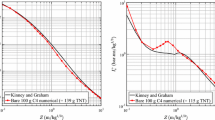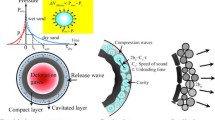Abstract
The explosive dispersal of a layer of solid particles or a layer of liquid surrounding a spherical high-explosive charge generates a turbulent, multiphase flow. Shock compression of the material layer during the initial acceleration may partially consolidate the material, leading to the formation of jet-like structures when the layer fragments and sheds particles upon release. Similarly, release of a shock-compressed liquid shell causes the nucleation of cavitation sites, leading to the radial breakup of the shell and the formation of jets upon expansion. In the current study, a wide variety of granular materials and liquids were explosively dispersed. The maximum terminal jet tip or shell velocity was measured using high-speed videography. Charges were constructed using thin-walled glass bulbs of various diameters and contained a central C-4 charge surrounded by the material to be dispersed. This permitted variation of the ratio of material mass to charge mass (M/C) from 4 to 300. Results indicated that material velocity broadly correlates with predictions of the Gurney model. For liquids, the terminal velocity was accurately predicted by the Gurney model. For granular materials, Gurney over-predicted the terminal velocity by 25–60%, depending on the M/C ratio, with larger M/C values exhibiting larger deficits. These deficits are explained by energy dissipation during the collapse of voids in the granular material bed. Velocity deficits were insensitive to the degree of jetting and granular material properties. Empirical corrections to the Gurney model are presented with improved agreement with the dry powder experimental velocities.












Similar content being viewed by others
References
Gurney, R.W.: The initial velocities of fragments from bombs, shell and grenades. Technical Report BRL-405, US Army Ballistic Research Laboratory (1943)
Milne, A.M.: Gurney analysis of porous shells. Propellants Explos. Pyrotech. 41(4), 665–671 (2016). https://doi.org/10.1002/prep.201600016
Frost, D.L., Gregoire, Y., Petel, O.E., Goroshin, S., Zhang, F.: Particle jet formation during explosive dispersal of solid particles. Phys. Fluids 24, 091109 (2012). https://doi.org/10.1063/1.4751876
Milne, A., Longbottom, A., Frost, D.L., Loiseau, J., Goroshin, S., Petel, O.: Explosive fragmentation of liquids in spherical geometry. Shock Waves 27(3), 383–393 (2017). https://doi.org/10.1007/s00193-016-0671-y
Milne, A.M., Floyd, E., Longbottom, A.W., Taylor, P.: Dynamic fragmentation of powders in spherical geometry. Shock Waves 24, 501–513 (2014). https://doi.org/10.1007/s00193-014-0511-x
Ripley, R.C., Zhang, F.: Jetting instability mechanisms of particles from explosive dispersal. J. Phys. Conf. Ser. 500(15), 152012 (2014). https://doi.org/10.1088/1742-6596/500/15/152012
Milne, A.M., Parrish, C., Worland, I.: Dynamic fragmentation of blast mitigants. Shock Waves 20(1), 41–51 (2010). https://doi.org/10.1007/s00193-009-0235-5
Frost, D.L., Loiseau, J., Goroshin, S., Zhang, F., Milne, A., Longbottom, A.: Fracture of explosively compacted aluminum particles in a cylinder. AIP Conf. Proc. 1793(1), 120019 (2017). https://doi.org/10.1063/1.4971701
Souers, P.C., Minich, R.: Cylinder test correction for copper work hardening and spall. Propellants Explos. Pyrotech. 40(2), 238–245 (2015). https://doi.org/10.1002/prep.201400135
Nesterenko, V.F.: Shock (blast) mitigation by soft condensed matter. In: MRS Symposium Proceedings, vol. 759, pp. MM4.3.1–4.3.12. Materials Research Society, Pittsburg (2003). https://doi.org/10.1557/PROC-759-MM4.3
Allen, R.M., Kirkpatrick, D.J., Longbottom, A.W., Milne, A.M., Bourne, N.K.: Experimental and numerical study of free-field blast mitigation. AIP Conf. Proc. 706(1), 823–826 (2004). https://doi.org/10.1063/1.1780363
Milne, A.M., Cargill, S.B., Longbottom, A.W.: Modelling of complex blast. Int. J. Prot. Struct. 7(3), 325–339 (2016). https://doi.org/10.1177/2041419616661431
Medvedev, S.P., Frolov, S.M., Gel’fand, B.E.: Attenuation of shock waves by screens of granular material. J. Eng. Phys. 58(6), 714–718 (1990). https://doi.org/10.1007/bf00872723
Pontalier, Q., Loiseau, J., Goroshin, S., Frost, D.L.: Experimental investigation of blast mitigation and particle-blast interaction during the high-explosive dispersal of particles and liquids. Shock Waves 28(3) (2018). https://doi.org/10.1007/s00193-018-0821-5
Pontalier, Q., Lhoumeau, M.G., Milne, A.M., Longbottom, A.W., Frost, D.L.: Numerical investigation of particle-blast interaction during explosive dispersal of liquids and granular materials. Shock Waves 28(3) (2018). https://doi.org/10.1007/s00193-018-0820-6
Henry, I.G.: The Gurney formula and related approximations for the high-explosive deployment of fragments. Technical Report PUB-189, Hughes Aircraft Company (1967)
Jones, G.E., Kennedy, J.E., Bertholf, L.D.: Ballistics calculations of R.W. Gurney. Am. J. Phys. 48(4), 264–269 (1980). https://doi.org/10.1119/1.12135
Dehn, J.T.: Models of explosively driven metal. Technical Report BRL-TR-2626, US Army Ballistic Research Laboratory, Aberdeen Proving Ground, MD (1984)
Kennedy, J.E.: The Gurney model of explosive output for driving metal. In: Zukas, J.A., Walters, W.P. (eds.) Explosive Effects and Applications, pp. 221–257. Springer, New York (1998). https://doi.org/10.1007/978-1-4612-0589-0_7
Reaugh, J.E., Souers, P.C.: A constant-density Gurney approach to the cylinder test. Propellants Explos. Pyrotech. 29(2), 124–128 (2004). https://doi.org/10.1002/prep.200400031
Kennedy, J.E.: Gurney energy of explosives: estimation of the velocity and impulse imparted to driven metal. Technical Report SC-RR-70-790, Sandia National Laboratories (1970)
Dehn, J.T.: Models of explosively driven metal. In: Short, J.M. (ed.) 8th International Symposium on Detonation, Albuquerque, 15–19 July, pp. 602–612. Office of Naval Research (1985)
Butz, D.J., Backofen, J.E., Petrousky, J.A.: Fragment terminal velocities from low metal to explosive mass ratio symmetric sandwich charges. J. Ballist. 6, 1304–1322 (1982)
Loiseau, J., Georges, W., Higgins, A.J.: Validation of the Gurney model in planar geometry for a conventional explosive. Propellants Explos. Pyrotech. 41, 655–664 (2016). https://doi.org/10.1002/prep.201500246
Solem, A.D., Singleton, B.H.: Rapid expansion of metal cylinders under explosive loading I: studies of initial expansions with rotating mirror camera. Technical Report NAVORD 2768, U.S Naval Ordnance Laboratory (1953)
Jacobs, S.J.: The Gurney formula: variations on a theme by Lagrange. Technical Report NOLTR 74-86. Naval Ordnance Laboratory (1974)
Weinland, C.E.: A scaling law for fragmenting cylindrical warheads. Technical Report NWC-TP-4735, Naval Weapons Center, China Lake (1969)
Hirsch, E.: Improved Gurney formulas for exploding cylinders and spheres using “hard core” approximation. Propellants Explos. Pyrotech. 11(3), 81–84 (1986). https://doi.org/10.1002/prep.19860110303
Flis, W.J.: Gurney formulas for explosive charges surrounding rigid cores. In: 16th International Symposium on Ballistics, San Francisco, CA, 23–28 September (1996)
Cooper, P.W.: Explosives Engineering. Wiley-VCH, New York (1996)
Walters, W.P., Zukas, J.A.: Fundamentals of Shaped Charges. Wiley-Interscience, New York (1989)
Danel, J.-F., Kazandjian, L.: A few remarks about the Gurney energy of condensed explosives. Propellants Explos. Pyrotech. 29(5), 314–316 (2004). https://doi.org/10.1002/prep.200400060
Souers, P.C., Lauderbach, L., Garza, R., Ferranti, L., Vitello, P.: Upgraded analytical model of the cylinder test. Propellants Explos. Pyrotech. 38(3), 419–424 (2013). https://doi.org/10.1002/prep.201200192
Hutchinson, M.D., Price, D.W.: On the continued acceleration of bomb casing fragments following casing fracture. Def. Technol. 10(2), 211–218 (2014). https://doi.org/10.1016/j.dt.2014.06.001
Loiseau, J., Georges, W., Frost, D.L., Higgins, A.J.: The propulsive capability of explosives heavily loaded with inert materials. Shock Waves (2018). https://doi.org/10.1007/s00193-017-0781-1
Allison, F.E., Watson, R.W.: Explosively loaded metallic cylinders. I. J. Appl. Phys. 31(5), 842–845 (1960). https://doi.org/10.1063/1.1735706
Allison, F.E., Schriempf, J.T.: Explosively loaded metallic cylinders. II. J. Appl. Phys. 31(5), 846–851 (1960). https://doi.org/10.1063/1.1735707
Acknowledgements
The authors thank Rick Guilbeault and Lorne McCauley at the Canadian Explosive Research Laboratory for assistance with the experiments and the Defense Threat Reduction Agency for funding under the basic research Grant HDTRA1-11-1-0014.
Author information
Authors and Affiliations
Corresponding author
Additional information
Communicated by J. Yang.
Publisher's Note
Springer Nature remains neutral with regard to jurisdictional claims in published maps and institutional affiliations.
Rights and permissions
About this article
Cite this article
Loiseau, J., Pontalier, Q., Milne, A.M. et al. Terminal velocity of liquids and granular materials dispersed by a high explosive. Shock Waves 28, 473–487 (2018). https://doi.org/10.1007/s00193-018-0822-4
Received:
Revised:
Accepted:
Published:
Issue Date:
DOI: https://doi.org/10.1007/s00193-018-0822-4




